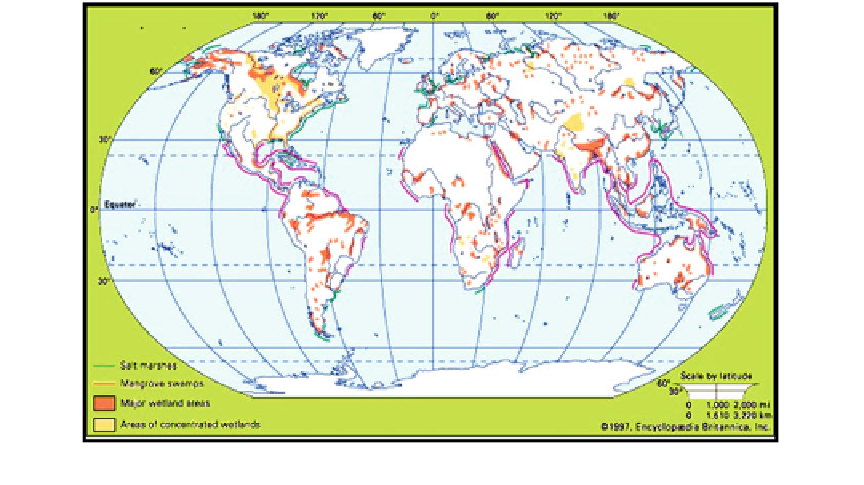Environmental Engineering Reference
In-Depth Information
Fig. 4.20
Map showing seagrass bioregions
soil as rhizomes and roots. The largest pools of
organic carbon stored in living seagrasses (with
mean living biomass of 7.29
3. Low degradation rate of organic carbon in
oxygen-poor soil substratum.
Fourqurean et al. (
2012
) compile published
and unpublished measurements of the organic
carbon content of seagrass biomass and under-
lying soils in 946 distinct seagrass meadows
across the globe. Using only data from sites for
which full inventories exist, they estimated that,
globally, seagrass ecosystems could store as
much as 19.9 Pg organic carbon. They also made
a very conservative approach incorporating
depth-wise decrease of organic carbon in soil and
estimated that the carbon pool in seagrass eco-
system lies between 4.2 and 8.4 Pg. They also
estimated that loss of seagrass community due to
dredging and
1.52 MgC ha
−
1
)
were found inMediterranean meadows dominated
by
±
, a large seagrass with
extensive, long-lived rhizomes.
DBD of seagrass soils had a wide range. The
median DBD of the entire data set was
0.92 g ml
−
1
, slightly lighter than the mean of
1.03
Posidonia oceanica
0.02 g ml
−
1
. Organic carbon of seagrass
soils varied widely, with a median measured
1.8 % of dry weight, and relatively infrequent
high values, resulting in a global average of
2.5 %. Assuming that the median DBD and
median organic carbon content of soils in the
database represent the central tendency of the top
metre of all seagrass soils worldwide, Fourqure-
an et al. (
2012
) estimated that the top metre of
seagrass soils contains 165.6 Mg organic carbon
ha
−
1
. It was also reported that soil organic carbon
decreased with depth.
The factors affecting the capacity of storing
carbon in seagrass are as follows:
1. Rate of primary production of seagrass (which
is very high).
2. Capacity of seagrass to
±
lling activities, change in land-use
pattern, degradation of water quality, etc., may
result in the release of up to 299 Tg carbon per
year to the atmosphere.
The present authors assessed the carbon in
major species of seagrass sampled from the Gulf
of Kutch region and documented the stored car-
bon within the range 30.9
33.8 % (Fig.
4.21
).
Very scanty references are available on the
mechanisms of carbon
-
xation in seagrasses and
questions concerning the kinetics of the active
forms of carbon utilized and possible photosyn-
thetic
lter out particles
from the water column and stored them in
underlying soils.
pathways. Steemann Nielsen
(
1975
)

